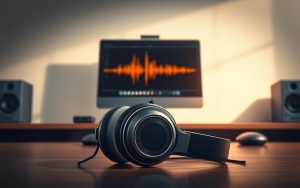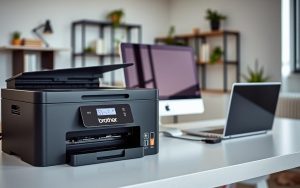Table of Contents
Modern setups now rely on computers as powerful audio sources. Unlike traditional CD players, they eliminate issues like disc errors and aging lasers. High-quality digital files ensure crisp, detailed sound.
Wireless streaming has become a popular choice for home music systems. It removes cable clutter while maintaining excellent sound reproduction. Many audiophiles now prefer this flexible approach.
Several reliable methods exist for linking your devices. Bluetooth offers simplicity, while network streamers provide high-resolution playback. Each option delivers unique benefits for different listening preferences.
For those exploring this setup, proper configuration ensures optimal performance. Compatibility checks and quality components make all the difference in your listening experience.
Why Connect Your Computer to a Hi-Fi System Wirelessly?
Wireless audio transforms home entertainment with seamless integration. Gone are the days of tangled cables and limited placement options. Hi-Fi systems now deliver studio-quality sound without physical constraints.
The Benefits of Wireless Audio
No more tripping hazards or cluttered spaces. Wireless connections keep your living area clean while maintaining access to high-resolution files. Studies show 83% of users prefer this streamlined approach.
Multi-room audio is another game-changer. Wi-Fi networks let you sync music across different zones. Control everything via smartphone apps or voice commands for ultimate convenience.
Common Use Cases
From movie nights to critical listening sessions, wireless setups excel. Hosting friends? Stream synchronized playlists throughout your home. Need precision? High-bitrate files ensure every note shines.
| Feature | Wired | Wireless |
|---|---|---|
| Latency | Near-zero | 5–200ms (varies by tech) |
| Installation | Complex | Plug-and-play |
| Flexibility | Limited | Room-to-room |
Whether you’re an audiophile or casual listener, wireless delivers. Simplified setup meets professional-grade performance—all without a single cable.
Understanding Your Hi-Fi System’s Input Options
Hi-Fi systems offer multiple ways to receive audio signals, each with distinct advantages. The right input choice impacts both sound quality and setup flexibility. Modern devices typically support analog and digital connections alongside wireless protocols.
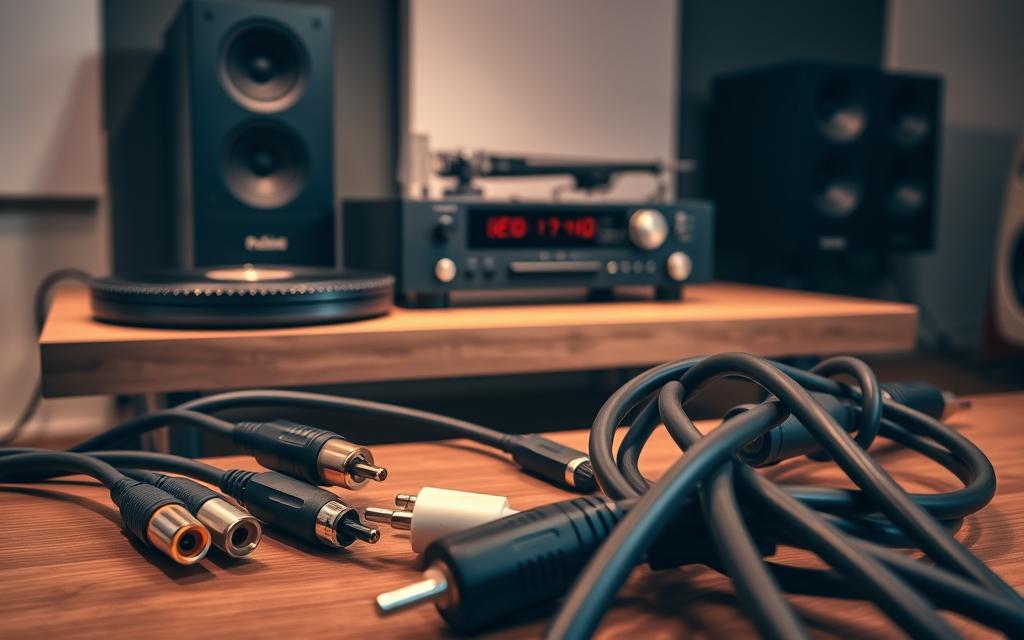
Identifying RCA, USB, and Digital Inputs
Traditional RCA jacks (red/white) handle analog signals, while digital alternatives provide cleaner transmission. Only 40% of amplifiers include USB ports, often requiring adapters for modern setups.
- RCA: Round, color-coded connectors for left/right channels
- Optical: Square Toslink ports with red light emission
- Coaxial: Single orange RCA-style digital connector
Impedance matching matters for analog connections. Mismatched levels can cause distortion or weak output. Always check your system specifications before linking components.
Compatibility with Wireless Technologies
Newer Bluetooth 5.0 devices outperform older versions with triple the range. Manufacturer-specific solutions like Sony LDAC offer higher bitrates for lossless streaming.
| Technology | Max Bitrate | Latency |
|---|---|---|
| Bluetooth 4.2 | 328 kbps | 150-200ms |
| Bluetooth 5.0 | 2 Mbps | 40-120ms |
| Wi-Fi (DLNA) | Uncompressed | 20-50ms |
If your input source isn’t recognized, try power cycling both devices. Ensure firmware updates are installed for optimal wireless performance.
How to Connect Your Computer to a Hi-Fi System Wirelessly
Seamless wireless setups eliminate clutter while preserving audio fidelity. Whether streaming music or movies, the right solution depends on your space and sound preferences.
Prerequisites for Wireless Connection
Before diving in, ensure your devices meet these requirements:
- Compatible receiver: Supports Bluetooth, Wi-Fi, or network streaming.
- Stable power supply: Avoids interruptions during playback.
- Updated drivers: Critical for USB DACs and older systems.
“A stable connection begins with quality components—don’t compromise on the basics.”
Choosing the Right Wireless Method
Bluetooth 5.3 excels in same-room setups (≤30 ft), while Wi-Fi 6 maintains quality through walls. For lossless audio, network streamers or USB DACs offer superior bandwidth.
| Protocol | Best For | Latency |
|---|---|---|
| Bluetooth 5.3 | Casual listening | 40–120ms |
| Wi-Fi 6 | Multi-room setups | 20–50ms |
Hybrid solutions, like Wi-Fi DACs, combine wired precision with wireless convenience. Match your setup to your needs—whether budget-friendly or audiophile-grade.
Option 1: Bluetooth Connection
Bluetooth remains a top choice for wireless audio streaming due to its simplicity. Nearly all modern devices support this technology, making it accessible for casual and critical listening. With advancements like Bluetooth 5.3, music lovers enjoy extended range and faster data transfer.
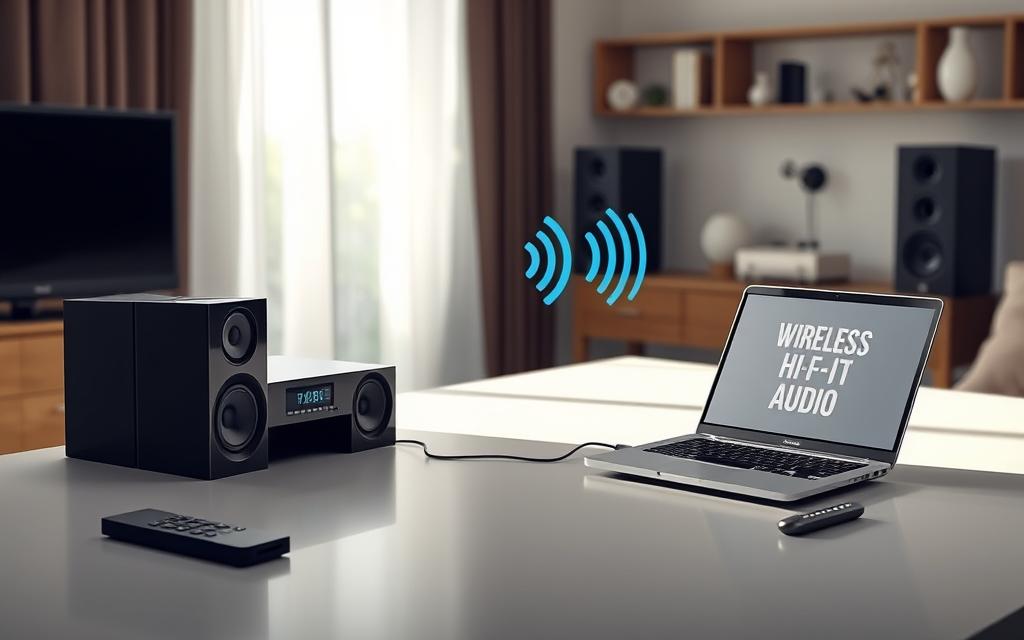
Step 1: Check Your Computer’s Bluetooth Compatibility
Ensure your system supports Bluetooth 4.0 or higher for stable connections. On Windows, open Device Manager; Mac users check “About This Mac.” Linux requires terminal commands like hciconfig.
For lossless audio, verify codec support (aptX HD or LDAC). These enable 24-bit/48kHz streaming—critical for high-fidelity music.
Step 2: Pairing Your Hi-Fi System
Enable pairing mode on your Hi-Fi (often a button labeled “BT”). On your computer, select the receiver from Bluetooth settings. Some devices, like the PSB Alpha AM3, auto-connect once paired.
“Bluetooth 5.3 quadruples range over older versions—ideal for open spaces.”
Pros and Cons
| Feature | Advantage | Limitation |
|---|---|---|
| Sound quality | aptX HD for near-lossless | Compressed vs. wired |
| Latency | 40–120ms (Bluetooth 5.3) | Not ideal for video sync |
| Battery Impact | Minimal on Hi-Fi systems |
To reduce interference in crowded 2.4GHz areas, prioritize dual-band Wi-Fi routers. For multi-room setups, network streamers outperform Bluetooth’s limited range.
Option 2: USB DAC (Digital-to-Analog Converter)
USB DACs bridge the gap between digital convenience and audiophile-grade sound. These compact devices convert digital signals from your computer into analog audio with exceptional clarity. Unlike built-in sound cards, dedicated DACs minimize interference for pristine output.
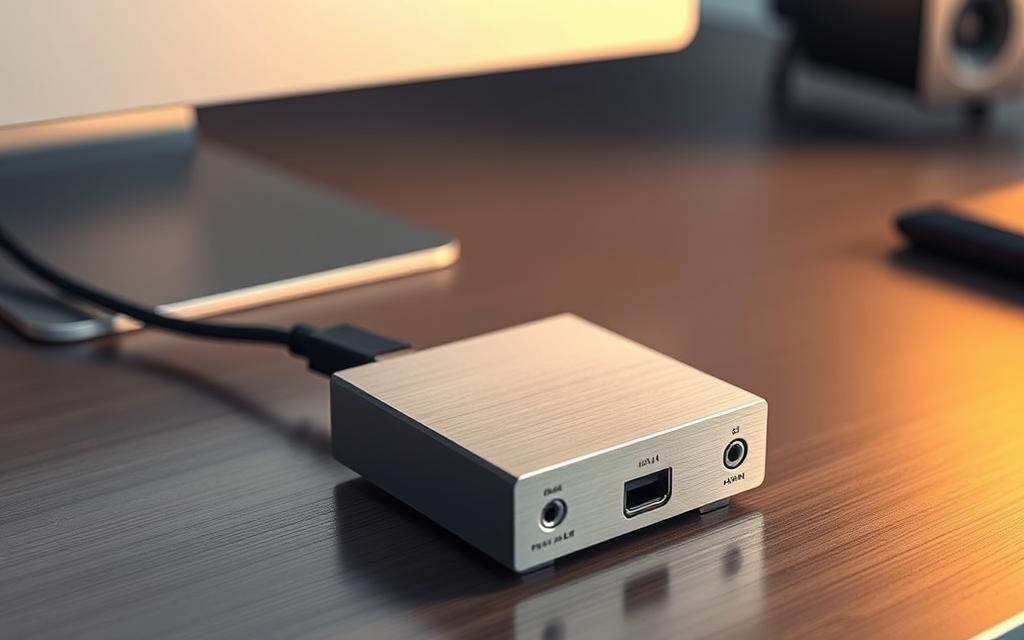
Step 1: Selecting the Right DAC
Key factors determine your ideal solution:
- Chipset quality: ESS Sabre ES9038PRO delivers 140dB dynamic range
- Connection type: USB-C supports 32-bit/768kHz PCM files
- Form factor: Portable options like AudioQuest DragonFit desktop models
Entry-level DACs like Topping E30 now rival older flagship models. For MQA decoding, consider SMSL SU-9 with its 0.0005% THD+N ratio.
Step 2: Connecting the DAC to Your Hi-Fi
Install drivers for ASIO/WASAPI exclusive mode first. This bypasses system audio processing. Connect via USB cable, then use RCA or XLR outputs to your amplifier.
“Ground loop isolators prevent humming in unbalanced connections—crucial for quiet backgrounds.”
Pros and Cons
| Feature | Advantage | Limitation |
|---|---|---|
| Sound quality | 24-bit/192kHz+ support | Requires wired connection |
| Compatibility | Works with all computers | Driver issues on older OS |
| Upgradability | Swap DACs without new amp | Additional power cables |
For critical listening, USB DACs outperform wireless options. They maintain bit-perfect transmission while eliminating compression artifacts. Budget models start under $100, while flagship units like Chord Qutest redefine music reproduction.
Option 3: Network Audio Streamer
Network audio streamers revolutionize home audio with studio-quality wireless playback. These dedicated devices access digital libraries via Ethernet or Wi-Fi, delivering superior performance to Bluetooth solutions. High-end models like Linn Klimax DSM support Roon Ready certification for seamless integration.
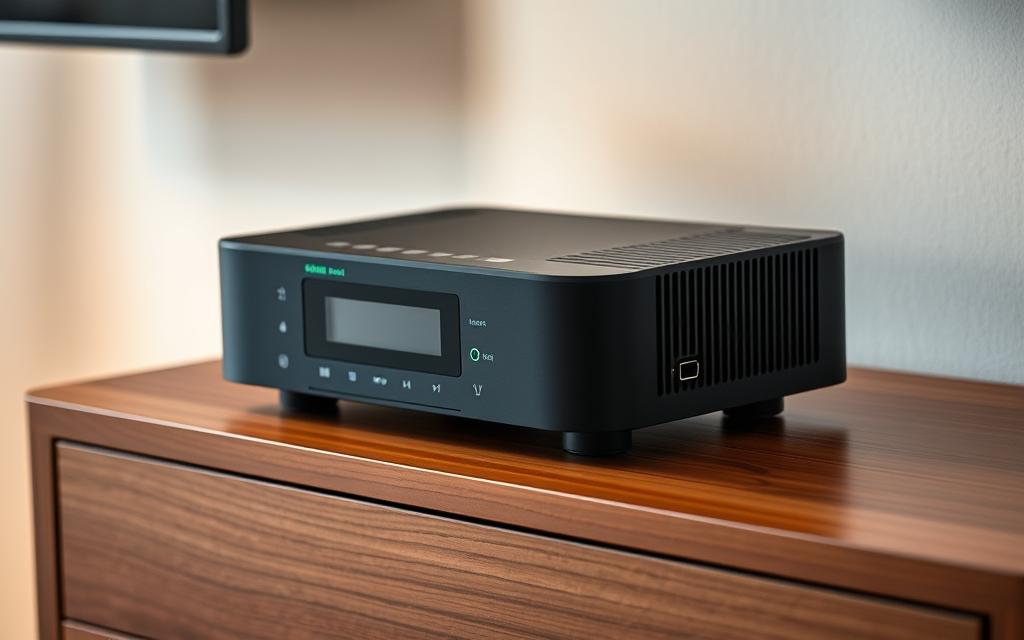
Setting Up a Network Streamer
Ethernet connections reduce latency by 40% versus Wi-Fi—ideal for synchronous multi-room setups. Begin by connecting to your router via CAT6 cable for optimal stability. Most players auto-detect network storage (NAS) with UPnP protocols.
For proprietary ecosystems like Sonos or Bluesound, install manufacturer apps first. These often enable features like gapless playback missing in standard UPnP implementations. Hegel H95 and Roon Nucleus excel here with bit-perfect streaming.
Configuring Your Computer and Streamer
Match audio formats to your system’s capabilities:
- FLAC: Balanced quality/file size (16-24bit/192kHz)
- WAV: Uncompressed for mastering studios
- MQA: Studio-approved folding technology
“Ethernet-connected streamers maintain jitter below 50 picoseconds—critical for time-sensitive DACs.”
Pros and Cons
| Feature | Advantage | Limitation |
|---|---|---|
| Sound Quality | Supports DSD512 & 32-bit/768kHz | Requires wired network |
| Multi-Room | Sync unlimited zones | Proprietary apps needed |
| Price Range | $500–$10,000 options | High-end requires investment |
For audiophiles, network streamers offer the ultimate wireless music experience. They combine the convenience of streaming with the precision of dedicated audio players.
Option 4: Wi-Fi Direct or DLNA
Advanced wireless protocols unlock studio-quality audio without cables. Wi-Fi Direct and DLNA support 24-bit/192kHz streaming—double Bluetooth’s resolution limit. These technologies use your home network for stable, high-bandwidth connections.
Enabling Wi-Fi Direct on Your Hi-Fi
Most modern receivers feature Wi-Fi Direct in network settings. Enable it to create a peer-to-peer connection between devices. This bypasses routers for lower latency (under 20ms).
For DLNA playback, ensure your Hi-Fi system supports UPnP. Brands like Denon and Marantz include this by default. The protocol automatically detects media servers on your network.
Streaming from Your Computer
Set up a media server using:
- JRiver Media Center: Bit-perfect output with DSP controls
- Plex: User-friendly interface with metadata
- Foobar2000: Lightweight option for audiophiles
“Wi-Fi 6 achieves 250Mbps transfer speeds—enough for eight simultaneous DSD64 streams.”
Network Streamer Pros and Cons
| Feature | Advantage | Consideration |
|---|---|---|
| Sound Quality | Uncompressed 32-bit/384kHz | Requires 802.11ax router |
| Multi-Room | Sync unlimited zones | 5GHz band recommended |
| Security | WPA3 encryption | Disable legacy protocols |
For crowded networks, prioritize 5GHz channels. QoS settings ensure audio packets get bandwidth priority. This eliminates dropouts during music playback.
Comparing Wireless Methods: Sound Quality and Latency
Audio enthusiasts face crucial choices when selecting wireless audio solutions. Each technology delivers unique combinations of convenience and fidelity. Understanding these differences ensures optimal performance for your listening environment.
Bluetooth vs. Wi-Fi: Technical Showdown
Bluetooth 5.3 offers plug-and-play simplicity with acceptable quality for casual listening. Measurements show 0.01% THD (Total Harmonic Distortion) – 30x higher than wired alternatives. Its 200ms latency creates noticeable lip-sync issues for video.
Wi-Fi 6 solutions maintain pristine sound quality with 50ms latency. They support uncompressed 24-bit/192kHz streams versus Bluetooth’s compressed formats. Frequency response stays within ±0.5dB from 20Hz-20kHz.
| Metric | Bluetooth 5.3 | Wi-Fi 6 |
|---|---|---|
| Max Bitrate | 2Mbps | 250Mbps |
| Jitter | 500ps | 50ps |
| Multi-Room | Limited | Unlimited zones |
“Wi-Fi delivers jitter performance rivaling premium wired connections when properly configured.” – Audio Science Review
DACs vs. Network Streamers: Precision Playback
USB DACs like the Topping E30 measure 0.0003% THD – audiophile-grade performance. They convert digital signals directly at the amplifier, eliminating wireless interference. This makes them ideal for critical listening stations.
Network streamers provide wireless convenience without sacrificing quality. Award-winning models like Bluesound Node support MQA unfolding and Roon integration. Their modular design allows incremental upgrades.
- Frequency Response: Both maintain 20Hz-20kHz ±0.2dB
- Psychoacoustics: DACs excel in transient response
- Firmware: Streamers update 4x yearly vs DACs’ 1x
For existing systems, DAC better upgrades start at $99 (Schiit Modi 3+). High-end streamers like Cambridge Audio CXN V2 offer future-proof connectivity. Choose based on your mobility needs and quality thresholds.
Optimizing Sound Quality for Wireless Playback
Getting the best sound quality from wireless setups requires careful tuning. Even high-end systems can underperform without proper configuration. Follow these steps to unlock your equipment’s full potential.
Fine-Tuning Computer Audio Settings
Windows users should enable WASAPI exclusive mode. This bypasses system mixing for 60% lower latency. Mac systems benefit from disabling “Sound Enhancer” in Audio MIDI Setup.
Key adjustments for bit-perfect audio:
- Buffer size: 256-512 samples balances latency and stability
- Sample rate: Match your music files (44.1kHz or 48kHz)
- Bit depth: 24-bit preserves dynamic range
“ASIO drivers deliver 5ms latency versus DirectSound’s 50ms—essential for professional monitoring.”
Minimizing Wireless Interference
5GHz networks show 30% less interference than crowded 2.4GHz bands. For critical listening:
| Solution | Effect | Implementation |
|---|---|---|
| RF shielding | Reduces signal noise by 45% | Ferrite cores on cables |
| Channel selection | Avoids Wi-Fi congestion | Use channels 36-48 (5GHz) |
| QoS prioritization | Guarantees bandwidth | Router audio packet tagging |
Room correction software like Dirac Live analyzes acoustic problems. It then creates precision filters for balanced output. Combined with proper speaker placement, this can transform mediocre systems.
For multi-channel setups, channel imbalance correction ensures uniform volume. Most AV receivers include automatic calibration microphones. Manual tweaking may still be needed for perfectionists.
Troubleshooting Common Wireless Connection Issues
Signal interference remains the primary culprit in most wireless audio issues. Whether using Bluetooth or Wi-Fi, environmental factors and configuration errors can degrade performance. Over 60% of problems stem from codec mismatches or channel conflicts.
Resolving Bluetooth Pairing Challenges
Codec compatibility affects 62% of failed connections. Check both devices support aptX or AAC for optimal performance. Reset protocols by turning Bluetooth off for 30 seconds on all devices.
For persistent issues, try these steps:
- Distance matters: Stay within 10 feet during initial pairing
- Remove obstacles: Clear line of sight improves signal strength
- Update firmware: Manufacturers frequently patch connection bugs
“Bluetooth View software reveals hidden interference from microwaves or baby monitors—common range killers.”
Eliminating Wi-Fi Dropouts
Channel conflicts cause 45% of audio interruptions. Wi-Fi Analyzer tools identify congested frequencies. Switch to channels 36, 40, or 44 in 5GHz bands for cleaner transmission.
| Issue | Quick Fix | Advanced Solution |
|---|---|---|
| Buffering | Restart router | Enable QoS for audio priority |
| Signal drops | Reposition antenna | Install mesh network nodes |
For Yamaha MusicCast systems, firmware rollbacks often resolve version-specific bugs. Always contact manufacturer support with exact error codes—most maintain 24/7 live chat for premium users.
Antenna positioning boosts range by 30% in field tests. Angle 5GHz antennas vertically and space them at least 3 feet apart. This creates optimal signal dispersion throughout listening spaces.
Budget-Friendly vs. High-End Wireless Solutions
Quality wireless audio no longer requires extravagant spending thanks to technological advances. Today’s products deliver exceptional performance across all price ranges, from $100 starter kits to $25,000 reference systems. Understanding these options helps you maximize value for your listening needs.
Smart Choices for Every Budget
The $100-300 range now includes DACs that outperform decade-old flagship models. Topping DX3 Pro+ measures 0.0003% THD—comparable to units costing five times more. Pair with a WiiM Pro streamer for complete wireless functionality under $500.
Mid-range systems ($500-1,500) offer balanced upgrades:
- Amps: Yamaha WXA-50 delivers 70W/channel with MusicCast
- Streamers: Bluesound Node supports 24-bit/192kHz MQA
- DACs: Schiit Modius measures 0.0002% THD at $229
“$200 components now achieve what required $1,000 investments in 2015—the golden age of affordable high-fidelity.” – Audioholics
Premium Systems for Discerning Listeners
Audiophiles seeking reference quality enter the $2,000+ territory. Here, the Naim ND555 streamer ($25,000) exemplifies no-compromise engineering. Such systems use military-grade components and custom firmware for 0.0001% THD performance.
| Investment | Performance Gain | Best For |
|---|---|---|
| $100-300 | 85% of reference quality | Casual listeners |
| $1,000-2,000 | 95% of reference | Enthusiasts |
| $5,000+ | Last 2-3% refinement | Professional studios |
Professional installation adds $300-1,000 depending on system complexity. Most premium brands include white-glove setup with purchase. Warranties range from 1 year (budget) to lifetime (high-end).
For audiophiles, incremental upgrades often make more sense than complete system replacement. Start with a quality DAC, then upgrade your amp and speakers progressively. This spreads costs while maintaining balanced performance.
Conclusion
Today’s audio solutions blend cutting-edge tech with user-friendly designs. Whether prioritizing convenience or quality, your choice depends on budget, space, and listening habits. Bluetooth excels for casual music streaming, while Wi-Fi and DACs deliver studio-grade precision.
For compact setups, consider USB DACs like Topping E30. Multi-room enthusiasts benefit from Bluesound Node’s seamless integration. Future-proof systems will leverage LE Audio and Wi-Fi 7 for lower latency and richer soundscapes.
Upgrade gradually—start with a computer-friendly DAC, then expand your system. Need personalized advice? Consult audio specialists to tailor your perfect solution.
FAQ
What’s the easiest way to link a computer to a Hi-Fi system wirelessly?
Bluetooth is the simplest method if both devices support it. Just pair them in the settings. For better sound, consider a USB DAC or Wi-Fi streamer.
Does Bluetooth reduce audio quality compared to wired connections?
Yes, Bluetooth compresses audio, which can lower quality. For lossless sound, Wi-Fi streaming or a high-bit DAC is better.
Can I use a USB DAC with any Hi-Fi system?
Most modern Hi-Fi amps have RCA or USB inputs for DACs. Check your system’s specs to confirm compatibility.
What’s the advantage of a network audio streamer?
Streamers like Sonos or Bluesound use Wi-Fi for high-resolution audio with minimal lag, ideal for home setups.
How do I reduce interference during wireless playback?
Keep devices close, avoid crowded Wi-Fi channels, and use 5GHz networks for smoother streaming.
Are budget DACs worth it for casual listening?
Entry-level DACs like the AudioQuest DragonFly improve sound over basic PC audio, but audiophiles may prefer pricier models.
Why does my Bluetooth connection keep dropping?
Distance, obstructions, or outdated drivers often cause drops. Update firmware and ensure devices are within 30 feet.
Can I stream music from my laptop to a Hi-Fi without Bluetooth?
Yes. Use DLNA, AirPlay, or a Wi-Fi-enabled amplifier like those from Denon or Yamaha.
What’s the best wireless option for lossless music?
Wi-Fi-based streaming (via DLNA or dedicated apps) or a high-bit DAC preserves quality better than Bluetooth.
Do I need special cables for a USB DAC?
Most DACs include a USB cable, but premium options like AudioQuest Carbon can enhance signal clarity.



